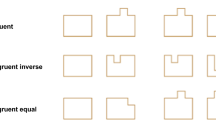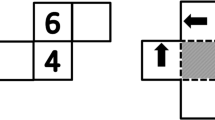Abstract
Students’ difficulties in mathematics and science may stem from interference of irrelevant salient variables. We focus on the comparison of perimeters task, in which area is the irrelevant salient variable. A previous fMRI brain-imaging study related to the comparison of perimeters task suggested that increasing the level of salience of the relevant variable, perimeter, would increase participants’ performance. The brain imaging results support and enrich previous behavioral data, and thus contribute to the development of our research rationale and intervention design. In the present study we increased the level of salience of the relevant variable by drawing the perimeters of the shapes as built from separate units, matchsticks (discrete mode of presentation), rather than drawing them continuously. Such increase in salience draws participants’ attention to the perimeter. Thus strategies (such as moving of segments and/or counting them, or applying formal geometrical knowledge), that are regularly used when solving the comparison of perimeters task become more available. We explored whether the discrete mode would yield a higher success rate than the continuous mode and whether an intervention of first performing the discrete mode would improve students’ success in a subsequent continuous mode. Findings show that success in the discrete mode was higher than in the continuous mode. Moreover, success in the continuous mode increased as a result of the intervention (i.e., when performed after discrete mode). The current study suggests that altering the mode or order of presentation can serve as an educational tool that may improve students’ performance.









Similar content being viewed by others
References
Aron, A. R., Robbins, T. W., & Poldrack, R. A. (2004). Inhibition and the right inferior frontal cortex. Trends in Cognitive Sciences, 8, 170–177.
Babai, R., Levyadun, T., Stavy, R., & Tirosh, D. (2006). Intuitive rules in mathematics and science: A reaction time study. International Journal of Mathematical Education in Science and Technology, 37, 913–924.
Babai, R., Sekal, R., & Stavy, R. (2010a). Persistence of the intuitive conception of living things in adolescence. Journal of Science Education and Technology, 19, 20–26.
Babai, R., Shalev, E., & Stavy, R. (2015). A warning intervention improves students’ ability to overcome intuitive interference. ZDM Mathematics Education, 47, 735–745.
Babai, R., Zilber, H., Stavy, R., & Tirosh, D. (2010b). The effect of intervention on accuracy of students’ responses and reaction times to geometry problems. International Journal of Mathematics and Science Education, 8, 185–201.
Brebner, J. T., & Welford, A. T. (1980). Introduction: An historical background sketch. In A. T. Welford (Ed.), Reaction Times (pp. 1–23). New York: Academic Press.
Clement, J. (1993). Using bridging analogies and anchoring intuitions to deal with students’ preconceptions about physics. Journal of Research in Science Teaching, 30, 1241–1257.
D’Amore, B., & Fandiño Pinilla, M. I. (2006). Relationships between area and perimeter: Beliefs of teachers and students. Mediterranean Journal for Research in Mathematics Education, 5, 1–29.
de Fockert, J. W., Rees, G., Frith, C. D., & Lavie, N. (2001). The role of working memory in visual selective attention. Science, 291, 1803–1906.
Dembo, Y., Levin, I., & Siegler, R. S. (1997). A comparison of the geometric reasoning of students attending Israeli ultraorthodox and mainstream schools. Developmental Psychology, 33, 92–103.
Denes, G., & Pizzamiglio, L. (1999). Handbook of clinical and experimental neuropsychology (pp. 28–30). Hove: Psychology Press.
Fias, W., Lammertyn, J., Reynvoet, B., Dupont, P., & Orban, G. A. (2003). Parietal representation of symbolic and nonsymbolic magnitude. Journal of Cognitive Neuroscience, 15, 47–56.
Hoffer, A. R., & Hoffer, S. A. K. (1992). Geometry and visual thinking. In T. R. Post (Ed.), Teaching Mathematics in Grades K–8: Research-based Methods (2nd ed.). Boston: Allyn and Bacon.
Lamy, D., Leber, A., & Egeth, H. E. (2004). Effects of task relevance and stimulus-driven salience in feature-search mode. Journal of Experimental Psychology: Human Perception and Performance, 30, 1019–1031.
Lavie, N. (2005). Distracted and confused? Selective attention under load. Trends in Cognitive Sciences, 9, 75–82.
Lavie, N., Hirst, A., de Fockert, J. W., & Viding, E. (2004). Load theory of selective attention and cognitive control. Journal of Experimental Psychology: General, 133, 339–354.
Leikin, R., Leikin, M., Waisman, I., & Shaul, S. (2013). Effect of the presence of external representations on accuracy and reaction time in solving mathematical double-choice problems by students of different levels of instruction. International Journal of Mathematics and Science Education, 11, 1049–1066.
Lleras, A., & Von Mühlenen, A. (2004). Spatial context and top-down strategies in visual search. Spatial Vision, 17, 465–482.
Maglio, P. P., Matlock, T., Raphaely, D., Chernicky, B., & Kirsh, D. (1999). Interactive skill in Scrabble. Proceedings of the Twenty-first Annual Conference of the Cognitive Science Society (pp. 326–330). Hillsdale: Lawrence Erlbaum Associates.
Marchett, P., Medici, D., Vighi, P., & Zaccomer, E. (2005). Comparing perimeters and area children’s pre-conceptions and spontaneous procedures. Proceedings CERME, 4, 766–776.
Martin, M. O., Mullis, I. V., Foy, P., & Stanco, G. M. (2012). TIMSS 2011 International Results in Science. Amsterdam: International Association for the Evaluation of Educational Achievement.
Martin, T., & Schwartz, D. L. (2005). Physically distributed learning: Adapting and reinterpreting physical environments in the development of fraction concepts. Cognitive Science, 29, 587–625.
Martin, L., & Schwartz, D. L. (2014). A pragmatic perspective on visual representation and creative thinking. Visual Studies, 29, 80–93.
Minsky, M. (1985). The Society of Mind. New York: Simon & Schuster.
Mullis, I. V., Martin, M. O., Foy, P., & Arora, A. (2012). TIMSS 2011 International Results in Mathematics. Amsterdam: International Association for the Evaluation of Educational Achievement.
OECD (2014). PISA 2012 Results: What students know and can do: Student performance in mathematics, reading and science (Volume I, Revised edition, February 2014). OECD Publishing, Paris. doi: 10.1787/9789264208780-en.
Palatnik, A. (2009). The effect of presentation mode on students’ responses in comparison of perimeters task. Unpublished seminar work, Tel Aviv University, Tel Aviv, Israel. (In Hebrew).
Pinel, P., Piazza, M., Le Bihan, D., & Dehaene, S. (2004). Distributed and overlapping cerebral representations of number, size, and luminance during comparative judgments. Neuron, 41, 983–993.
Shultz, T., Dover, A., & Amsel, E. (1979). The logical and empirical bases of conservation judgments. Cognition, 7, 99–123.
Sobel, K. V., & Cave, K. R. (2002). Roles of salience and strategy in conjunction search. Journal of Experimental Psychology: Human Perception and Performance, 28, 1055–1070.
Stavy, R. (1991). Using analogy to overcome misconceptions about conservation of matter. Journal of Research in Science Teaching, 28, 305–313.
Stavy, R., & Babai, R. (2008). Complexity of shapes and quantitative reasoning in geometry. Mind, Brain, and Education, 2, 170–176.
Stavy, R., & Babai, R. (2010). Overcoming intuitive interference in mathematics: Insights from behavioral, brain imaging and intervention studies. ZDM - The International Journal on Mathematics Education, 42, 621–633.
Stavy, R., & Berkovitz, B. (1980). Cognitive conflict as a basis for teaching quantitative aspects of the concept of temperature. Science Education, 64, 679–692.
Stavy, R., Goel, V., Critchley, H., & Dolan, R. (2006). Intuitive interference in quantitative reasoning. Brain Research, 1073–1074, 383–388.
Stavy, R., & Tirosh, D. (2000). How Students (Mis-)understand Mathematics and Science. New York: Teachers College Press.
Tamsut, E. (2014). The effect of a preliminary task which strengthens the conservation of perimeter on accuracy and reaction time of comparing perimeters. Unpublished Master’s thesis, Tel Aviv University, Tel Aviv, Israel. (In Hebrew).
Tirosh, D., & Tsamir, P. (1996). The role of representations in students’ intuitive thinking about infinity. International Journal of Mathematical Education in Science and Technology, 27, 33–40.
Tsamir, P. (2003). From “easy” to “difficult” or vice versa: The case of infinite sets. Focus on Learning Problems in Mathematics, 25, 1–17.
Walter, N. (1970). A common misconception about area. Arithmetic Teacher, 17, 286–289.
Woodward, E., & Byrd, F. (1983). Area: Included topic, neglected concept. School Mathematics and Science, 83, 343–347.
Zink, C. F., Pagnoni, G., Martin-Skurski, M. E., Chappelow, J. C., & Berns, G. S. (2004). Human striatal responses to monetary reward depend on saliency. Neuron, 42, 509–517.
Author information
Authors and Affiliations
Corresponding author
Rights and permissions
About this article
Cite this article
Babai, R., Nattiv, L. & Stavy, R. Comparison of perimeters: improving students’ performance by increasing the salience of the relevant variable. ZDM Mathematics Education 48, 367–378 (2016). https://doi.org/10.1007/s11858-016-0766-z
Accepted:
Published:
Issue Date:
DOI: https://doi.org/10.1007/s11858-016-0766-z




